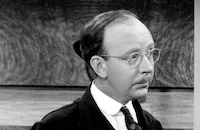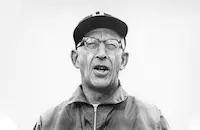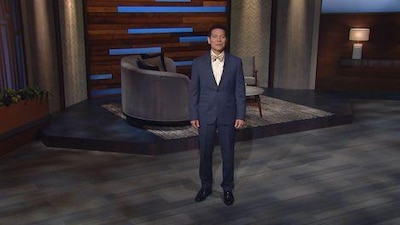Broadway Thru a Keyhole

Brief Synopsis
Cast & Crew
Lowell Sherman
Constance Cummings
Paul Kelly
Russ Columbo
Blossom Seeley
Gregory Ratoff
Film Details
Technical Specs

Synopsis
Frank Rocci, a familiar but feared patron of Broadway establishments, is the president of a protection racket that demands one dollar per coop from poultry companies for assurance that "accidents" do not occur. When a childhood neighbor from the Bronx, Esther Whelan, visits and tells him that her mother has died and her sister Joan needs a job, Rocci arranges with Tex Kaley, owner and hostess of the Klub Kaley, and the perfectionistic, but easily intimidated, impresario Max Mefoofski to put Joan in the chorus. After Rocci gives Joan the eye during her first number, he invites her to his apartment, but when she speaks innocently of their childhood and says she feels she can trust him, Rocci curbs his salacious inclinations and takes her home. Rocci then buys the club and demands that Max star Joan in his new revue. After Walter Winchell's column links Joan and Rocci, Esther, greatly upset, confronts her sister, but she stands up for Rocci. Joan is a success, and Rocci sets her up in a Park Avenue apartment. As he talks about marriage and implies that he will ask her once he is able to get out of the racket, gunshots from a rival shatter the window and mirror. For her protection, Rocci sends Joan to Miami with Sybil Smith, the girl friend of Rocci's lieutenant, Chuck Haskins. At a dinner show, radio croooner and bandleader Clark Brian invites Joan to sing with him. Although Joan discovers that Clark is a chronic hypochondriac and he admits he is a coward, during the next couple of weeks they grow fond of each other. After the funeral of the rival responsible for the gunshots in Joan's apartment, Rocci reconciles with his main rival, Tim Crowley. When Rocci calls Joan to tell her she can return, she says she wants to stay a little longer. Just then, a telegram arrives from one of Rocci's pals in Miami, stating that he saw Joan with Clark. Rocci immediately orders Joan to take the next plane. When she returns to New York, Rocci asks Joan about Clark, but because she is afraid to hurt Rocci, she says that Clark means nothing to her. Clark follows and visits Joan at the club. She warns him about Rocci, but when he says that he will not be afraid if she loves him, she acknowledges her love. Rocci confronts Clark, who says that he wants to marry Joan and that he is willing to die for her if necessary. After some hesitation, Rocci tells him to be good to her and leaves. When Joan is hijacked after the wedding, a battered Clark accuses Rocci. Crowley, who engineered the kidnapping, tells Rocci that he had Joan taken to a hotel room to please him. Rocci then goes there, and Crowley tips off the police, who shoot Rocci in the corridor. At the hospital, Rocci gives his blessing to Joan and Clark. Comforted by Winchell's column, which exonerates him with regard to Joan's kidnapping, and by the news that Crowley has been shot, Rocci wistfully looks out over the lights of Broadway.

Director

Lowell Sherman
Cast

Constance Cummings

Paul Kelly

Russ Columbo
Blossom Seeley

Gregory Ratoff
Texas Guinan
Abe Lyman And His Band

Hugh O'connell

Hobart Cavanaugh
Frances Williams
Eddie Foy Jr.
Barto And Mann

C. Henry Gordon
William Burress
Helen Jerome Eddy
Bradley Ward
John Kelly
Franklin Ardell

Charles Levinson
Ronnie Cosbey
Marceline Medcalf
Arthur Franklin
Fred Santley

Lucille Ball
Edith Allen
Rodney Hildebrand
Tom London
Billy Sullivan
Ethan Laidlaw
George Mcgrill
Crew
Tom Andre
B. S. Ansley
Graham Baker
Dick Billings
Ray Binger
Sam Brown
Alice Carey
Richard Day
Grace Dubray
Ed Ebele
Fred Fox
William Goetz
Mack Gordon
Raymond Griffith
Bert Hadley
Jack Haskell
Dick Hunsaker
Vernon Jones
Kay Kendall
Ed. Larkin
Edna Mae
Peverell Marley
Pat Mccoy
Barney Mcgill
Thomas Moulton
Alfred Newman
Harry Revel
Ernest Rotchy
Helene Ruppert
W. J. Scully
Isabelle Sheridan
Walter Stegmeier
Orville Stewart
Gene Towne
John Walker
William Whitley
Howard C. Wilson
Walter Winchell
Joseph Wright
Maurice Wright
Darryl F. Zanuck

Film Details
Technical Specs

Articles
Broadway Through a Keyhole - Broadway Through a Keyhole
The chorus girl character was in part a thinly disguised take on the life of dancer/singer/actress Ruby Keeler, and Keeler's real-life husband, Al Jolson, did not take kindly to it. When he encountered Winchell at an open-air boxing match in Hollywood in July 1933, after the script was set for production, an argument and fisticuffs ensued; two weeks later, Winchell sued Jolson for $500,000 over the incident. Winchell also drew inspiration for the character, however, from the life of Ruth Etting, and the result was an unofficial composite of sorts. In any case, the incident between Winchell and Jolson reaped producer Darryl Zanuck a publicity bonanza and helped the film's box office. (Zanuck produced the film for his newly-formed 20th Century Pictures, which had a distribution arrangement with United Artists.)
One of the story elements that tied the Constance Cummings character to Ruby Keeler is that the film has Cummings working in the chorus for a club owner named Tex Kaley, played by the legendary speakeasy hostess/promoter/actress Texas Guinan, essentially playing herself. Keeler had previously worked for Guinan in real life. Guinan died shortly after this film's release, at age 49.
There's another famous showbiz personality on hand, too: Blossom Seeley, a veteran vaudeville star making a very rare film appearance, one of just three features she was ever in. She gets the chance to spout off numerous entertaining double entendres.
Leading lady Constance Cummings had already made nearly twenty pictures since starting her film career two years earlier, and in several ways Broadway Through a Keyhole paralleled her own rise to stardom from chorus girl beginnings. Shortly after making this film, she married Benn W. Levy, a distinguished British playwright and screenwriter whose screen credits included Blackmail (1929), Waterloo Bridge (1931), and The Old Dark House (1932). In 1935, after starring in Remember Last Night? (1935), Cummings would re-locate to England and resume her film and stage career there. She died in England in 2005, at age 95.
Cummings's leading man in Broadway Through a Keyhole is Russ Columbo, a highly popular romantic crooner of the era who was just starting what looked to be an impressive acting career. He'd had a few bit parts in recent years but now was being featured and billed prominently, and the industry and critics were taking notice; he garnered uniformly excellent reviews for his fine, sincerely-felt performance here. Sadly, tragedy struck. Ten months after this film's release, on September 2, 1934, Columbo died by accidental gunshot. After a dinner one night, a friend of Columbo's showed him an antique gun, unaware it was loaded. The lighting of a match triggered the explosive charge and a lead bullet was fired; it ricocheted off a table and struck Columbo in the face, and he died instantly. Columbo was romantically involved with Carole Lombard at the time of his death, and she, along with his family members, decided not to tell Columbo's mother what had happened, for fear the news would kill her, as she had recently suffered a heart attack and was in the hospital. Supposedly they kept up the ruse for years, even after Lombard's own death in a 1942 plane crash, until the mother died in 1944, by writing letters and telegrams and making up excuses for Russ not to see her. Columbo's final film, Wake Up and Dream, was released a month after he died.
Also in the cast are an assortment of fascinating bit players. Lucille Ball makes one of her earliest screen appearances, as a chorus girl; Dennis O'Keefe makes one of his almost 200 uncredited bit parts before he'd finally get credit in 1938, with greater success coming in the 1940s; Ann Sothern, as a singer, has her last uncredited bit before starting to get onscreen credit with Let's Fall in Love (1933); and the ubiquitous Charles Lane makes one of his own earliest appearances, though the word "earliest" in his case is relative; he'd already been in nearly twenty pictures since 1930. He'd go on to appear in over 350 total movies and television shows in a career as a character actor that stretched to 1995. He died in 2007 at age 102.
Director Lowell Sherman had had a prominent acting career stretching back to 1914, and in 1930 he started a transition to director. His resume as such includes She Done Him Wrong (1933), Morning Glory (1933), and Night Life of the Gods (1935). Broadway Through a Keyhole was his eleventh directorial effort. He would go on to complete two more films and then start directing Becky Sharp (1935), the first full-length 3-strip Technicolor feature. But during production, in December 1934, he died of pneumonia, and Rouben Mamoulian came on to complete the film. Had he not died, Sherman might well have gone on to a much more significant directing career.
Broadway Through a Keyhole was well received. "Granted that the story is far from wholesome," said The New York Times, "it does capture one's attention, chiefly through the forceful performance of Paul Kelly as Frank Rocci." Variety deemed Russ Columbo to be "surprise of the picture," and said he "may go places. He shows traces of camera shyness and unfinished delivery, but that can be overcome."
Variety also praised the musical numbers but said "more would have been welcome." Indeed, the movie downplays its numbers, though the few that are there are well staged. The songs by Mack Gordon and Harry Revel include "You're My Past, Present, and Future," "When You Were the Girl on the Scooter," "Doing the Uptown Lowdown," and "I Love You Pizzicato."
By Jeremy Arnold
SOURCES:
William M. Drew, At the Center of the Frame
William K. Everson, The New School program notes, July 1976
Michelle Morgan, The Mammoth Book of Hollywood Scandals

Broadway Through a Keyhole - Broadway Through a Keyhole
Broadway Thru a Keyhole
Based on a story by Broadway columnist Walter Winchell, the film stars Constance Cummings as Joan, an aspiring dancer helped in her career by a gangster. Soon, she is a nightclub star. Rocci, the gangster, is in love with Joan, but although she is grateful, she falls for the club's crooner (Russ Columbo). Broadway Thru a Keyhole features top nightclub and theater stars, including famed club owner Texas Guinan, who plays a fictionalized version of herself. Blossom Seeley and Gregory Ratoff provide comic support. Look for future stars Lucille Ball, in a bit part in a beach scene, and Ann Sothern as a chorus girl. For a lighthearted movie musical, though, there was a lot of real-life drama, scandal, and tragedy associated with the people involved in Broadway Thru a Keyhole.
Broadway insiders recognized the film's story as based on a real-life romantic triangle that had played out a few years earlier between dancer Ruby Keeler, entertainer Al Jolson (who married Keeler in 1928), and mobster Larry Fay, who had reportedly been romantically involved with Keeler during her Broadway days. Shortly before Broadway Thru a Keyhole began production, Jolson ran into Winchell at a boxing match and punched him, citing reports about the forthcoming film as the reason. Winchell was quoted in the press as suggesting that Jolson should play the lead in the film himself. The real-life Fay had been shot and killed by a disgruntled employee the previous New Year's Eve.
Paul Kelly, who plays the gangster Rocci, had been acting on stage and in silent films since childhood. His career came to an abrupt halt in 1927, when he got into a drunken fight with the husband of a woman with whom Kelly was having an affair. The man died of a brain hemorrhage soon after, and Kelly was convicted of manslaughter. Broadway Thru a Keyhole was Kelly's first film after serving more than two years of a ten-year prison sentence. After his release he was eventually able to rebuild his career. For the next two decades, he earned plaudits for his work both onscreen and in the theater.
Broadway Thru a Keyhole was the second film for crooner Russ Columbo, just twenty-five years old, then one of the most popular singers and songwriters of the era. He wasn't much of an actor, but his brooding Italian good looks and his mellow voice made him a fan favorite. Sadly, he was killed in what was apparently a freak accident the following year, when an antique gun a friend was holding discharged and the bullet hit Columbo in the head. Texas Guinan died shortly after Broadway Thru a Keyhole opened, and director Lowell Sherman died the following year
20th Century Pictures had a longer and happier life than many of those involved in the film. In 1935, the company merged with the bankrupt Fox Film studio, and for more than eighty years has been one of the film industry's leading studios.
Director: Lowell Sherman
Producer: Darryl F. Zanuck
Screenplay: Gene Towne, Graham Baker, from a story by Walter Winchell
Cinematography: Barney McGill, Peverell Marley
Editor: Maurice Wright
Art Direction: Richard Day
Music: Songs by Mack Gordon and Harry Revel
Principal Cast: Constance Cummings (Joan Whelan), Paul Kelly (Frank Rocci), Russ Columbo (Clark Bryan), Blossom Seeley (Sybil Smith), Gregory Ratoff (Max Mefoofsky), Texas Guinan (Tex Kaley), Hugh O'Connell (Chuck Haskins), Hobart Cavanaugh (Peanuts Dinwiddie), Frances Williams (Singer), Eddie Foy, Jr. (Joan's Partner)
85 minutes
by Margarita Landazuri
Broadway Thru a Keyhole
Quotes
Trivia
Film is based so exactly on the courtship of Ruby Keeler and Al Jolson that Jolson, having read the script, knocked Walter Winchell out when they meet accidently at the Hollywood American Legion stadium on the night of July 21, 1933. Ruby Keeler, who was a dancer at Tex Guinan's night club, was dating the gangster Larry Fay when she met Jolson. Fay visited Jolson after hearing of this just to tell him that he can marry her.
Notes
The title card for this film reads, "Walter Winchell's Broadway Thru a Keyhole. Some reviews called the film Broadway Through a Keyhole. The film's working title was Broadway Love. According to news items, Darryl Zanuck paid gossip columnist Walter Winchell $25,000 for the story of this film.
News items state that Zanuck rushed the production because of the national publicity concerning a fistfight between Winchell and Al Jolson at a boxing arena. In a subsequent statement to the press, Jolson said that sometime before the fight, he learned that Winchell's story for this film was in fact the story of Jolson's romance with Ruby Keeler, to whom he was married, and that the story "tried to show some connection" between a gangster, who resembled Larry Fay, a recently slain New York gangster, and Keeler. On the night of July 21, 1933, Winchell entered the Hollywood American Legion Stadium and passed by Jolson and Keeler on his way to his ringside seat. Jolson then confronted Winchell and punched him. According to Winchell, Jolson hit him only one time; however, Jolson said he hit Winchell four or five times. Winchell and Zanuck denied that the story for the film was based on Jolson and Keeler, although Winchell stated that his story was based on the life of Fay and "a woman who is now happily married." In a statement to the press, Winchell said he was grateful for the publicity and suggested that Jolson play the lead role in the film. According to a Hollywood Reporter news item, in August 1933 Winchell sued Jolson for $50,000 alleging assault and damages. No information has been located concerning the disposition of the suit.
News items and information in the Twentieth Century-Fox Produced Scripts Collection note the following: Peggy Hopkins Joyce was originally cast as "Sybil Smith," but she collapsed on the set from an illness on the second day of production and was replaced by Lilyan Tashman; Tashman withdrew two days later because of adhesions from an appendicitis operation and was replaced by Blossom Seeley; Ginger Rogers was originally signed to play "Joan Whelan"; Zanuck was negotiating with Jack Benny to play a role; Edward Ellis was originally cast as "Tim Crowley"; Stuart Erwin was pulled from the cast during the first week of shooting to return to his home lot of M-G-M for an immediate assignment and was replaced on this film by Hobart Cavanaugh; James Sauers was originally cast as "Willie Stacko"; and scenes were shot at St. Brendan's Catholic Church in Los Angeles, a beach house in Santa Monica and United Airport in Burbank (which in 1934 changed its name to the Union Air Terminal). This was the first film for dance orchestra leader and popular radio singer Russ Columbo and for Blossom Seeley.
Correspondence in the MPAA/PCA Collection at the AMPAS Library reveals that in 1935, PCA Director Joseph Breen, wrote to Zanuck that the film "seems to be not acceptable under the provisions of the Production Code as currently administered. It is our belief that this picture, in its treatment of crime, definitely belongs in the old category of gangster pictures which the industry agreed to abandon." According to modern sources, the cast included the following: Andrew Tombes, Dennis O'Keefe (then known as Bud Flanagan), Ann Sothern and Wheeler Oakman. Modern sources also note that this was Lucille Ball's first film.















